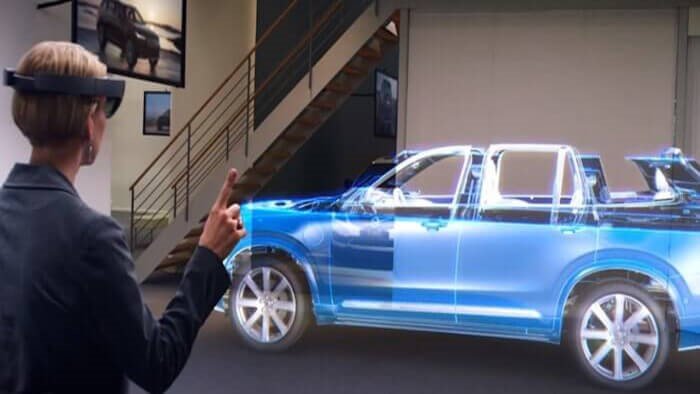Interactive e-commerce experience
Virtual reality technologies are gaining popularity across the country and are increasingly finding their way into more and more areas of our digital and, consequently, real lives. Whether for personal enjoyment, gaming, animated learning and the explanation of processes, or the interactive presentation of products: as technology continues to advance, VR and AR will soon become our constant companions – including in e-commerce.
With the growing popularity of virtual and augmented reality, more and more companies are asking themselves what role these technologies will play in their online presence in the near future. Virtual worlds are having a particularly strong impact on e-commerce, as VR and AR offer entirely new presentation and sales opportunities. Currently, most companies primarily use virtual reality as a marketing tool. For example, the use of VR devices at trade fairs has become a widespread way to present products to visitors in a more vivid and engaging manner.
In comparison, the e-commerce sector is lagging behind. This is partly due to the fact that many products are simply less suited to the new technology. For example, VR technology is rarely found on retailers' websites for consumer goods, books, or white goods. However, this limited adoption could also be due to a lack of compelling ideas for presenting these items. The use of virtual reality components becomes significantly more exciting and promising when it comes to products or services associated with entertainment, fashion, lifestyle, or travel.
Virtual worlds in online shopping
In e-commerce, virtual reality offers the opportunity to at least partially compensate for a major disadvantage compared to brick-and-mortar retail: the inherent distance between online customers and the product. Virtual reality can reduce this distance and offer consumers a quasi-real shopping experience. This is also the reason why some of the major online retailers are already experimenting with the technology or are already using it.
Providers of fashion and entertainment products, in particular, can benefit from integrating VR elements, as this allows them to approximate the online sales experience of their goods to that of a traditional brick-and-mortar store. This is a promising approach, as surveys indicate that potential customers appreciate such efforts. According to these surveys, over fifty percent of Germans are interested in virtual reality solutions for shopping.
Brands like The North Face by sending their customers on a virtual journey with VR image films. But this approach is still too short-sighted, because especially in the fashion sector, many customers feel the desire to try on the merchandise or at least examine it closely. This is difficult to achieve with product photos, no matter how detailed. Virtual reality can provide a good solution here by creating virtual fitting rooms. This allows customers to better test the selected items online. Large e-commerce companies like Otto , Zalando , and Adidas are already experimenting with the system, in which customers can try on garments with the help of VR and then view them in a 360-degree view. Ideally, the item, examined in such detail, is purchased immediately, so that the retailer only has to retrieve it from the warehouse and ship it to the customer.
Digital presentation formats have also arrived in the tech industry. Since the beginning of December 2016, Saturn in selected stores virtual reality shopping using Microsoft's HoloLens . During their virtual tour of the store, customers are shown images, videos, and additional information about the displayed Xbox and other devices.
E-commerce worlds in virtual shops
Some providers are taking this a step further by setting up entire virtual stores. Visitors navigate the online shop using VR headsets, just like in a traditional brick-and-mortar store. Compared to conventional online shops, retailers have significantly more opportunities for cross-selling and upselling, as they can present the most relevant items to the customer side-by-side in a much more visual and engaging way. Algorithms sort suitable items based on the customer journey and previous purchases to predict customer demand. This ensures that each customer is always presented with the items that have the highest sales potential.
Amazon , the Seattle-based e-commerce giant, has long recognized the potential of VR for e-commerce and is rumored to be planning to build a virtual reality platform . In terms of VR implementation, competitor eBay already a step ahead: In Australia, the internet company, together with the department store chain Myer, opened a virtual warehouse . Thanks to integrated Sight Search technology, customers can scan, select, examine, or add products directly to their shopping cart. The shop features more than 12,500 items, with the 100 best-selling products in each category even displayed in 3D. Various personalization features are designed to ensure that the shop perfectly matches each customer's individual taste, allowing for optimal customization of the product range with every virtual visit.
Combination of VR and interaction in the modern online shop
The Japanese online retailer Kabuki is expected to expand its webshop with a virtual reality section, including integrated voice chat, sometime in 2017. Customers will be able to shop using a VR headset via an app and discuss items with friends using the chat function. Just like in a brick-and-mortar store, customers will be able to consult with each other before making a purchase and add other items to their selection. This social interaction is intended to make it easier for customers to decide on a specific product.
The sportswear provider Moosejaw an extra dose of entertainment by offering customers virtual outdoor activities in its VR app. Visitors can discover new products on various courses, answer quiz questions, and win prizes. By adding this gaming element, the company hopes to strengthen customer relationships and communication, ultimately boosting sales.
Car dealership with many VR options
Car manufacturers are practically predestined for VR-based shopping. Why go to a dealership when you can experience all models in every imaginable color and trim level realistically from the comfort of your own home using VR glasses, and even configure your desired model right away? Volvo is particularly progressive in this regard, offering an app that allows customers to embark on virtual discovery tours. The American startup Vroom is following a similar path, planning to sell used cars through virtual showrooms , including the option of virtual test drives. Instead of endlessly visiting dealerships, potential buyers can test drive up to five different cars within minutes – all from the comfort of their own homes.
Conclusion
Sooner or later, virtual reality will become prevalent in many e-commerce segments. The main reason for this is the growing range of VR hardware available. These don't necessarily have to be products designed for Microsoft's high-priced HoloLens or Facebook's Oculus Rift, whose sales success is limited by their price. However, with the spread of more affordable solutions, the use of and demand for such products in online shopping will increase rapidly.
Due to the complexity of the technology and its diverse applications, beginners should consult with experts who can provide support for their virtual presence. It's crucial that online retailers also ensure their product range is suitable for virtual presentation and that their target audience can be reached through this technology. If both of these conditions are met, virtual reality transforms online shopping into a completely new experience for the user. The positive outcome for the retailer: KPIs such as the conversion rate will increase, while undesirable processes like abandoned carts, forgotten items, and returns will be minimized.


